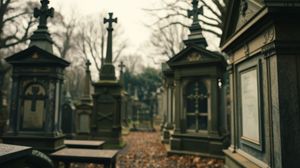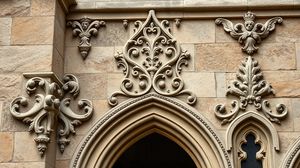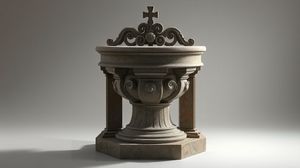
Brompton Cemetery is one of the iconic and grand garden cemeteries of London, serving as a peaceful oasis in the bustling city. Established in 1840, it forms part of the Magnificent Seven, a series of cemeteries created to ease the overcrowding in London parish graveyards.
Designed by architect Benjamin Baud, the cemetery is laid out in a distinctive formal grid pattern, influenced by the layout of Roman architecture. Its impressive entrance and chapel closely resemble St. Peter's Basilica in Rome, adding a touch of grandeur to this Victorian-era cemetery.
Among its many notable interments, Brompton Cemetery is the final resting place of Emmeline Pankhurst, the pioneering suffragette who played a significant role in the fight for women's voting rights in the UK.
While exploring Brompton Cemetery, visitors often come across the unusual gravestone of Frederick Leyland, a wealthy shipowner whose tomb resembles an Egyptian pyramid, reminiscent of his fascination with Egyptian culture.
The cemetery spans over 39 acres and features an abundance of wildlife, making it a haven for bird watchers and nature enthusiasts. It's home to rare fungi and an impressive collection of old trees, which add to its serene charm.
Brompton Cemetery is cared for by The Royal Parks, adding to its status as both a historic site and a public park. The grounds are open every day, providing an accessible retreat for those wishing to reflect and enjoy this rich piece of London's heritage.

Making the Most of Your Visit:
Start at the main entrance near Old Brompton Road for the best initial impression. The monumental entrance gates set the tone for the historic grandeur of the site, offering a view down the grand central avenue lined with impressive monuments and mature trees.
Don't miss the iconic catacombs beneath the central avenue. They're rarely open to the public, but from time to time there are guided tours that offer a rare glimpse into these atmospheric and historically significant burial sites.
Take a moment to search for the gravestones with epitaphs that reveal intriguing stories about the individuals buried here. Some display beautiful and poetic inscriptions that provide insight into the Victorian era sentiments about life and death.
Visit the final resting place of Emmeline Pankhurst, and reflect on her tremendous contribution to women's rights. Her grave tends to attract tributes, and visiting here provides a deeper connection to Britain's social history.
If you're a wildlife enthusiast, bring a pair of binoculars. Brompton Cemetery is home to a range of bird species, and the peaceful environment provides a great opportunity to engage in some bird-watching amidst the historical surroundings.

Visiting Times & Costs:
Brompton Cemetery is open to the public daily, offering visitors free access to explore its historical and serene grounds. The cemetery operates during daylight hours, with specific opening times varying slightly between the summer and winter months:
- March to October: Open from 7:00 AM to 7:00 PM
- November to February: Open from 7:00 AM to 4:00 PM
Admission to the cemetery is free, and visitors can wander at their leisure. However, guided tours, which might include access to restricted areas like the catacombs, may have a fee. These tours are not regularly scheduled, so it's advisable to check for availability in advance if this is of interest.
As with many historic sites, Brompton Cemetery has some accessibility considerations. The main pathways are generally accessible, but some areas may have uneven ground or steps which could present challenges for those with mobility issues. Visitors are encouraged to plan accordingly, particularly if wheelchair access is required.

Address & Map:

Nearby:























